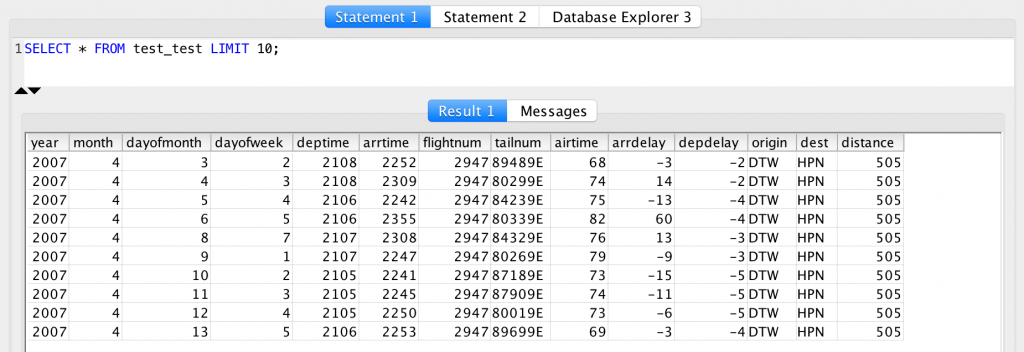This is the second episode of my SQL for Data Analysis (for beginners) series, and today I’ll show you every tiny little detail of the SQL WHERE clause. It’s not by accident that I’ve dedicated a whole article to this topic; the WHERE clause is essential if you want to select the right bit of your data from your data table!
In the first half of this article I’ll show you the different operators. In the second half, we will finally import our favorite 7.000.000+ rows dataset (the one with the airplane delays). And at the end of the tutorial, I’ll give you a few assignments to test your SQL knowledge and practice a bit!
If you are new here, let’s start with these articles first:
- How to install Python, SQL, R and Bash (for non-devs)
- SQL for Data Analysis – Tutorial for Beginners – ep1
- How to install SQL Workbench for postgreSQL
How to Become a Data Scientist
(free 50-minute video course by Tomi Mester)
Just subscribe to the Data36 Newsletter here (it’s free)!
Thank you!
You have successfully joined our subscriber list.
Make sure your SQL data environment works!
If you have already done the above mentioned articles, you most probably have these in place… but just in case, please double-check if you have these three things:
- Your fully-functioning data server (from this article)
- SQL Workbench with an established connection to your data server (from this article)
- The
zoodata set (from this article)
Check-check-check? Okay, you are ready to learn new things!
SQL WHERE Clause
Note: to get the most out of this article, you should not just read it, but actually do the coding part with me! So if you are on the phone, I suggest you save this article and continue on a computer!
In SQL for Data Analysis episode 1 we did this from the Terminal, but this time please re-run this query from SQL Workbench:
SELECT * FROM zoo WHERE animal = 'elephant';

This is the most basic example of how to use the SQL WHERE clause. But you can (and have to) be more sophisticated.
SQL WHERE with comparison operators
Well first of all – you can do more than “something equals something.” It can be “greater than,” “less than”,” “not equals to,” etc…
Here’s a short list of the comparison operators that work with the SQL WHERE clause:
| comparison operator | What does it mean? |
= | equals to |
<> | not equals to |
!= | not equals to |
< | less than |
<= | less-equal than |
> | greater than |
>= | greater-equal than |
Let’s see some concrete examples:
1. How would you select all the animals, that are not zebras?
Solution:
SELECT * FROM zoo WHERE animal <> 'zebra';
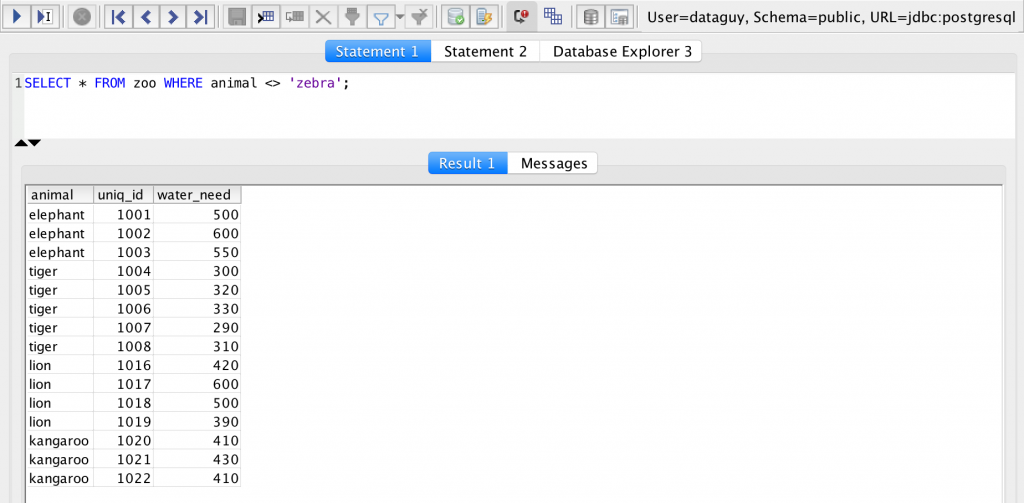
2. How would you select all the animals for whom the water_need is less than 300?
Solution:
SELECT * FROM zoo WHERE water_need < 300;
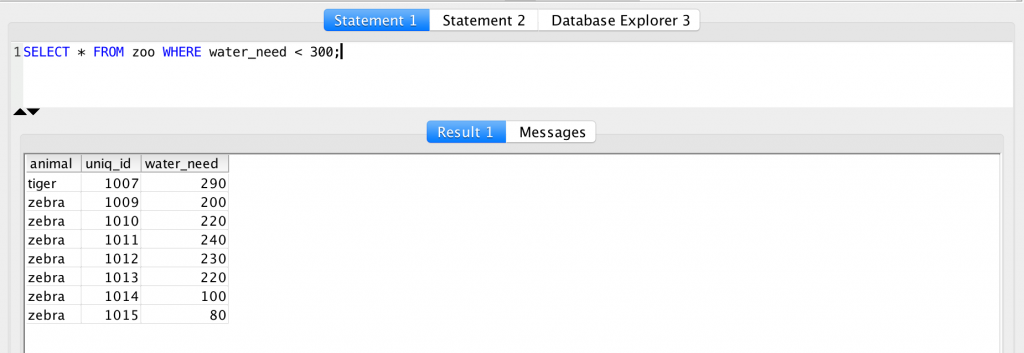
Okay, I think you got it!
So let’s take this to the next level!
SQL WHERE clause with LIKE operator
Sometimes you want to do your selection based on a pattern. Take a look at this fictional data set:
| user_name | user_id |
| frank | 1001 |
| franky | 1002 |
| frankenstein | 1003 |
| francis | 1004 |
| frappuccino | 1005 |
Let’s say, you want to select all the rows where the user_name starts with ‘frank‘.
Now it’s time to boost your WHERE clause with a LIKE operator:
SELECT * FROM franks WHERE user_name LIKE 'frank%';
How does it work?
The LIKE logical operator is just like the >, = or != — so it’s a comparsion operator. But it tells SQL that you want to filter results based on a pattern — and not on an exact value. Once you typed LIKE you specify what the pattern is exactly. Let’s say it’s 'frank%'! Do you see anything tricky here? Yepp, it’s the % character – which in this case means that any string of characters (of any length) can follow frank.
Hence your result will be:

To hammer this home, let’s go back to our zoo dataset and try to answer these questions:
1. How would you select all animals whose name contains at least one e character?
Solution:
SELECT * FROM zoo WHERE animal LIKE '%e%';
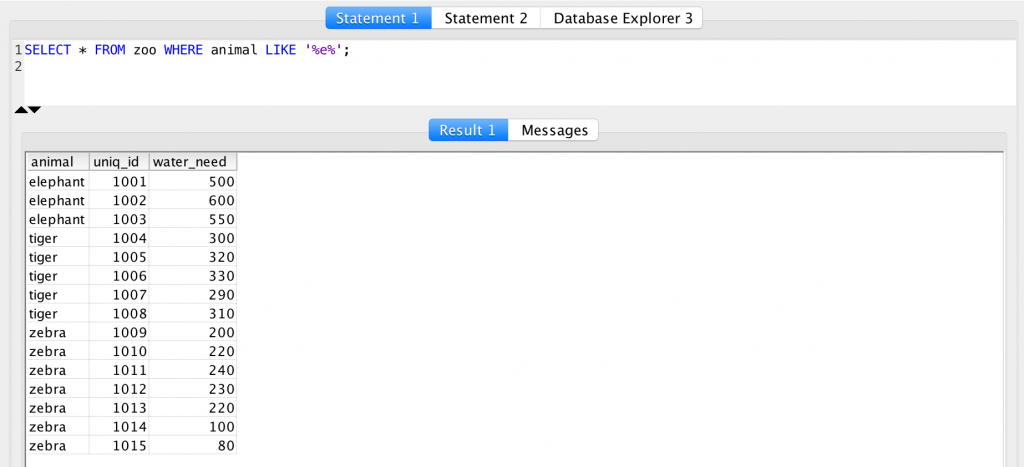
It needed a % at the beginning and also at the end of the pattern, because the ‘e‘ character could be anywhere in the word, not just at the end or the beginning. (If you don’t get it, try removing the first % and you will understand it immediately!)
2. How would you select all animals whose name ends with ‘roo‘?
Solution:
SELECT * FROM zoo WHERE animal LIKE '%roo';

There is another type of tricky character: _. (Oh, by the way, from now on I’ll just use its official name: wildcard.)
%means any string of characters of any length._means any character you want, but only one.
E.g. the word tiger can be found using wildcards like 't%'. But you can use 't____' too.
Knowing this trick, here’s another short question:
3. How would you select all animals whose species name is exactly five characters long?
Solution:
SELECT * FROM zoo WHERE animal LIKE '_____';
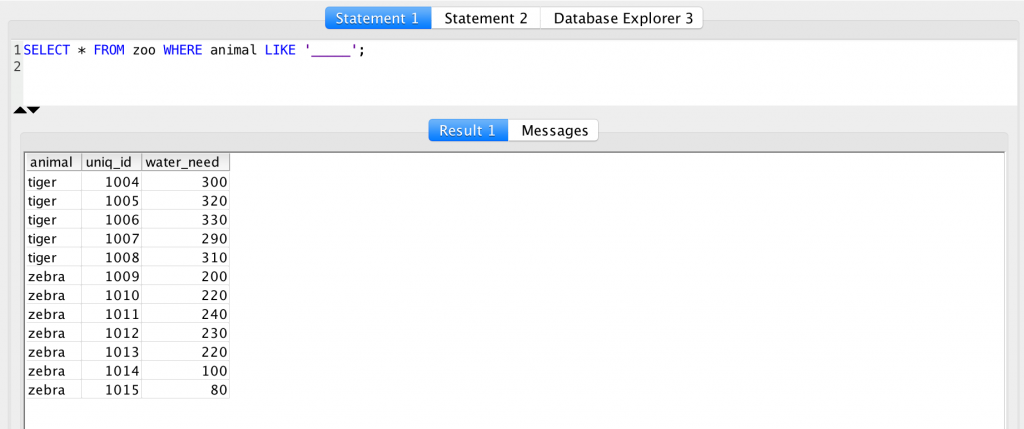
This is how the SQL WHERE clause works with the LIKE operator.
How to combine different conditions in an SQL WHERE clause
You can combine multiple conditions — using logical operators! There are more, but here I’ll highlight the two most important: AND and OR.
Let’s say we want to select all the animals whose name is exactly five characters long, except for tigers. We have two conditions and we can do that with SQL WHERE boosted with the AND logical operator.
SELECT * FROM zoo WHERE animal LIKE '_____' AND animal <> 'tiger';
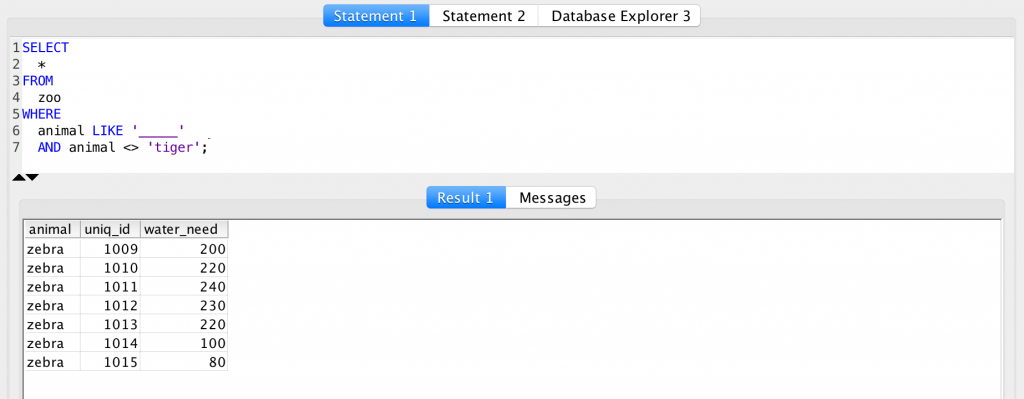
Nice, zebras only!
Now twist it a bit and select only those animals, that:
- have a name exactly five characters long
- are not
tigers - have a
water_needgreater than200
Solution:
SELECT
*
FROM
zoo
WHERE
animal LIKE '_____'
AND animal <> 'tiger'
AND water_need > 200;
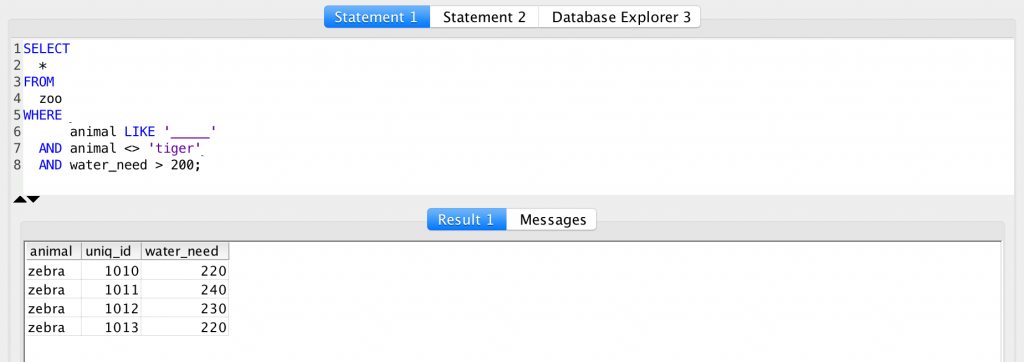
Yes: you can use multiple AND operators.
Finally, let’s see an example of the OR operator!
SELECT * FROM zoo WHERE water_need < 300 OR animal = 'lion';
It returns all the animals that are lions, plus all the animals that have less than 300 water_need.
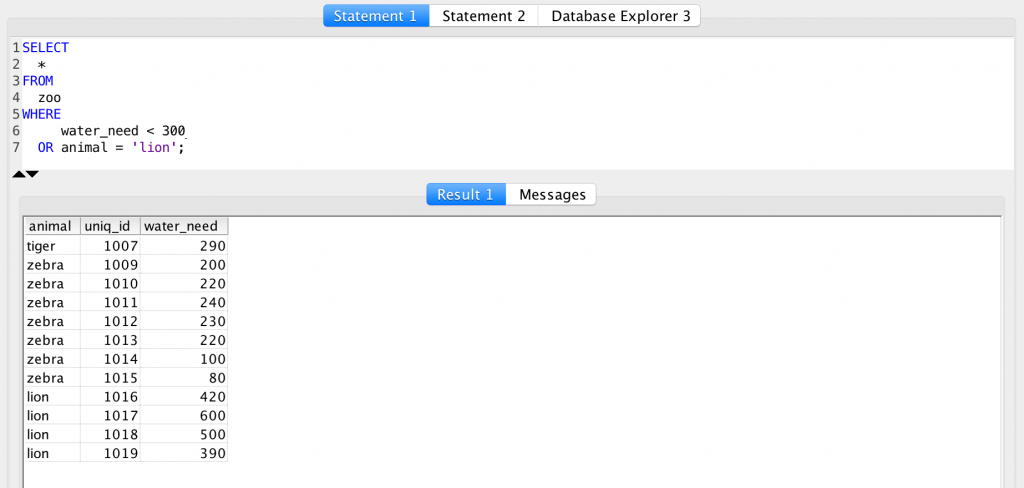
Get it?
ANDreturns every row where all the conditions are true.ORreturns every row where at least one of the conditions is true.
The Junior Data Scientist's First Month
A 100% practical online course. A 6-week simulation of being a junior data scientist at a true-to-life startup.
“Solving real problems, getting real experience – just like in a real data science job.”
The SQL IN operator
Imagine a situation where you want to select all the animals whose unique id is any of these: 1001, 1008, 1012, 1015, 1018.
You have already learned a way to do that! Can you find it out?
It’s the SQL WHERE clause with multiple OR operators. Something like this:
SELECT * FROM zoo WHERE uniq_id = 1001 OR uniq_id = 1008 OR uniq_id = 1012 OR uniq_id = 1015 OR uniq_id = 1018;

While it’s a valid solution, it’s certainly not the most elegant way to get the job done! If you want to reduce the number of ORs in your SQL WHERE clause, you should use the IN operator instead.
This SQL query returns the exact same result as the previous one:
SELECT * FROM zoo WHERE uniq_id IN (1001,1008,1012,1015,1018);

It’s a little bit shorter — so it’s much nicer. (You know, when it gets to coding, we don’t like to repeat things.)
The SQL NOT operator
There is an extra logical operator, which is by the way extremely simple. NOT will modify your logical operator to do its opposite instead. Let’s get back to a previous example with the 5 characters long animals:
SELECT * FROM zoo WHERE animal LIKE '_____';
How to select all the animals that are not 5 characters long?
SELECT * FROM zoo WHERE animal NOT LIKE '_____';

Simple as that.
Import a bigger dataset into postgreSQL
Are you bored with our 22-row zoo dataset? Me too! It’s time to go a bit bigger! Let’s import the 7.000.000+ row air-delays dataset we have used before in the bash tutorials! Follow these steps to have it imported into your SQL database!
Note: we will work in bash. If you haven’t done my bash tutorial series yet, I highly recommend doing at least the first episode, but if you don’t want to, it’s also okay to simply follow my lead step by step below.
- Open Terminal and login (
ssh) to your data server! - Download the
flight_delaysdata!wget http://stat-computing.org/dataexpo/2009/2007.csv.bz2Note: If you have this already, skip forward to 5.As of 29 December 2019, I realized that the dataset has been removed from its original place. Now, you can download the dataset using this code instead:wget 46.101.230.157/sql_tutorial/2007.csv - Format your data!
cat 2007.csv |cut -d',' -f1,2,3,4,5,7,10,11,14,15,16,17,18,19 | grep -v ',NA' > sql_ready.csv - Now we have to give permission to our postgreSQL user to create tables and load data into them. This will need multiple steps. Here’s a gif first (note: my username is
dataguy– yours might be something else).First
sudoto the user calledpostgres:sudo -u postgres -i
Then start postgreSQL:psql
The prompt will change to this:postgres=#
Type:ALTER USER [your_user_name] WITH SUPERUSER;
This turns your original user into a super user.
Exiting from postgreSQL. Type:\q
Then exit from the user calledpostgres:exit
Finally access your original user’s postgreSQL database from the command line:psql -d postgres
Okay, this was the hard part… - Now all you need to do is create the table by simply copy-pasting these lines into your terminal:
CREATE TABLE flight_delays ( year INTEGER, month INTEGER, dayofmonth INTEGER, dayofweek INTEGER, deptime INTEGER, arrtime INTEGER, flightnum INTEGER, tailnum VARCHAR, airtime INTEGER, arrdelay INTEGER, depdelay INTEGER, origin VARCHAR, dest VARCHAR, distance INTEGER);
- And finally, copy the data from the .csv file you have just downloaded!
COPY flight_delays FROM '/home/tomi/sql_ready.csv' DELIMITER ',' CSV HEADER;
Note: make sure that you type your user name where I’ve typedtomiordataguy(which are my user names…) - Go back to SQL Workbench and make a simple
SELECTstatement… but make sure that you use theLIMITclause, too. Why?
Because now you have over 7.000.000 rows of data. PostgreSQL can handle it easily, sure, but your computer might be frozen if you try print all that data on your screen.
So try something like this first:SELECT * FROM flight_delays LIMIT 10;
Test yourself #1
Here’s assignment number one:
How many flights did the plane with the tail-number N253WN take on 23 April, 2007?
(Hint: as we haven’t learned the COUNT function yet, it’s enough if you print all the flights with the given conditions and count the lines for yourself.)
.
.
.
Done? Here’s my solution:
SELECT * FROM flight_delays WHERE month = 4 AND year = 2007 AND dayofmonth = 23 AND tailnum = 'N253WN';

The only trick is that the day, the month and the year are in different columns, so you have to use multiple AND operators to filter simultaneously for all the conditions.
(Note: since the month, year and dayofmonth fields are integers, you don’t need apostrophes. But you need it for the tailnum field, because it contains letters too. I’ll get back to this topic later.)
Test yourself #2
Select all the rows with these conditions:
- the flight was in April 2007
- it was an even weekday (2nd, 4th or 6th day of the week)
- the flight distance was less than 50 miles
- either the departure or the arrival delay was less than 0 (means the plane took off or landed earlier than planned)
(Hint: you will have to use OR and AND operators together!)
.
.
.
And my solution is:
SELECT
*
FROM
flight_delays
WHERE month = 4
AND year = 2007
AND dayofweek IN (2,4,6)
AND distance < 50
AND (arrdelay < 0
OR depdelay < 0);
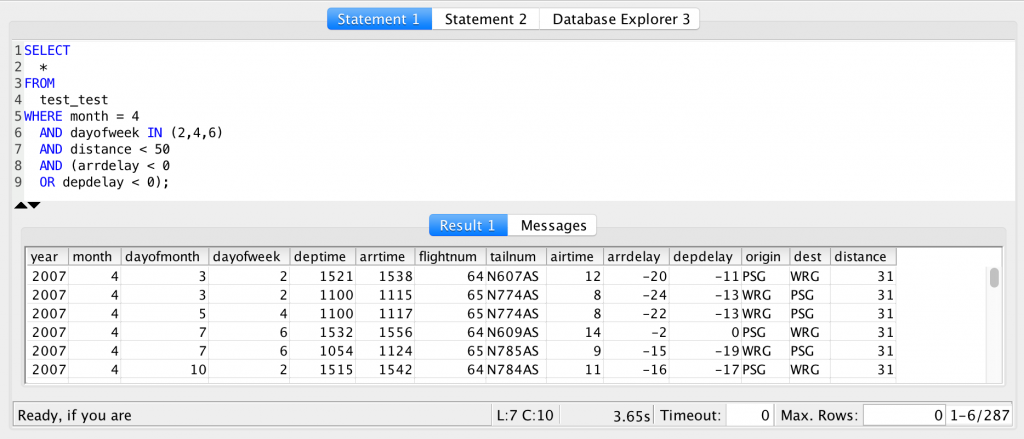
Can you see the trick here? In SQL WHERE clauses AND is stronger by default than OR – thus if you don’t use the parentheses, the execution order of the different filters would be like this:
WHERE (month = 4 AND dayofweek IN (2,4,6) AND distance < 50 AND arrdelay < 0) OR (depdelay < 0);
And that would have returned wrong results! Take-away is: always use parentheses when adding multiple conditions in your WHERE clause — so SQL can priortize the right filters.
Conclusion
Knowing, understanding and using SQL WHERE clauses with the right operators is crucial. In this article you have learned the most important parts of it.
Now – having a good base knowledge – it’s time to continue with the next important SQL topic! In my next article, I’ll introduce the basic SQL functions (MAX, MIN, SUM, COUNT) and I’ll show you some more important clauses (ORDER BY, GROUP BY, DISTINCT).
You can continue by clicking here.
- If you want to learn more about how to become a data scientist, take my 50-minute video course: How to Become a Data Scientist. (It’s free!)
- Also check out my 6-week online course: The Junior Data Scientist’s First Month video course.
Cheers,
Tomi Mester
Cheers,
Tomi Mester
Sources:
- http://stat-computing.org/dataexpo/ — shout out for the awesome dataset!

 First
First 